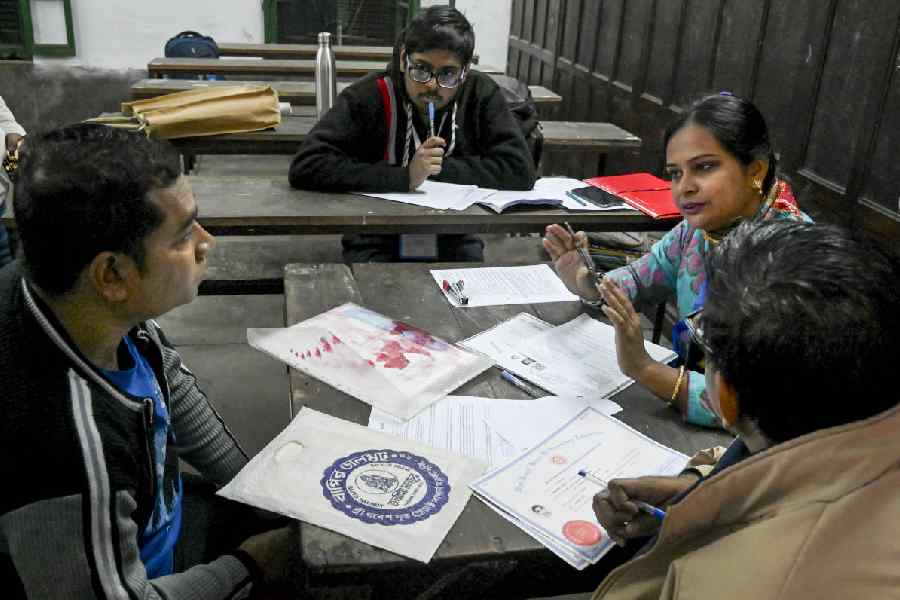 |
| Belinda Wright at ICCR on Tuesday. Picture: Rashbehari Das |
Wildlife photographer and filmmaker-turned-conservationist Belinda Wright is always passing through Calcutta on her way to the Sunderbans, where her Wildlife Protection Society of India (WPSI) has been running a community outreach programme since 2002. But on August 6, the lady with the smiling blue eyes stopped at ICCR to take part in a discussion on a travel diary, The Safari, by Sundeep Bhutoria. After the discussion, Belinda spoke to t2 about conservation, citizen action and her life-long connect with Calcutta.
Tell us about your childhood and initial wildlife encounters...
I had the most brilliant childhood of anyone I know! But my encounter with wildlife and animals was well before the Wildlife Protection Act (1972). We had lots of rescued animals in the house and when I got tucked into bed as a child, there would be a little red panda tucked up in a miniature bed beside mine! Dogs on my bed, deer in a corner and mongoose by my pillow... it was a fabled childhood.
I was born in Calcutta and most of my early years were spent here. But holidays were in the jungles in Bihar. Oh, it was wonderful, magical, marvellous.
When I was very young, there was no such thing as conservation. Anybody could go into the jungle and there was social hunting. Of course there were permits, a permit-hunting system and stuff like that, but it wasn’t a movement as such. That came a bit later, when I was in my teens.
I have lived in this amazing time when I saw the birth of the present-day conservation movement. WWF India, when it was formed, my mother (Anne Wright) was one of the original trustees. Then there was Indira Gandhi, who was very instrumental in [setting up] Project Tiger.... It’s been an incredible experience.
What’s it like being the daughter of Anne and Bob Wright?
My parents were very, very strong characters and I was kind of keen not to live in their shadows but to be my own person. I just didn’t want to be an appendage, and I think that was very important. So I broke off quite early. They weren’t very thrilled when I announced at the age of 14 that I wanted to be a wildlife photographer. They said, “What? There is no such thing that could be considered as a career.” But that’s what I wanted to do, so I made it my career.
Coming back to Calcutta, what are the places and memories that come back to you?
There are huge changes (in the city), but I think Calcutta in the monsoon, it’s… it’s just amazing. It’s like turning the clock back in many ways. It’s so beautiful this time of the year. So vibrant, clean, green. There have been times when I have come back and felt miserable because of the many changes. But not this time. I think the monsoon is very kind in a way to the visual appeal of the city. Like this morning, The Tollygunge Club looked breathtaking and magnificent. The fact that there was this huge temporary structure in the middle of Tolly Club, I almost didn’t see it since the rest was so beautiful.
When I was little I loved New Market, I used to spend all my time in the animal market, it doesn’t exist anymore. And then Tollygunge, it’s always been such a huge focus in my life.
Alipore zoo has started an adopt-an-animal campaign. Your views?
I don’t think it has anything to do with wildlife conservation, but if it helps improve the way the animals are looked after and hopefully brings a bit of awareness on the species, then I think it could be very useful.
What else can be done to improve the facilities for the zoo animals?
Last time I went to Alipore zoo, it was absolutely dreadful. I don’t think zoos in India play much of a role in conservation of species. I wish they would. But first they have to get their own house in order. Calcutta zoo has an amazing history. It’s one of the oldest zoos in India. It needs to improve its enclosures and other things before it can be proud of anything.
From wildlife photographer and filmmaker to conservationist, what gave you the push?
Because I am obsessed about tigers. I always have been. I discovered or rather stumbled upon the poaching of tigers in Madhya Pradesh and that somewhat tipped the balance. I instantly made the decision to put away the camera and do this full- time. To do it properly, I had to get into conservation full time.
Is Bengal a hot spot for the tiger trade?
Recently, not too much. But in the early 1970s and ’80s, yes. There were some major traders based in Calcutta then. Though there is still poaching and trading going on.... Wherever there is a wild tiger, there is poaching. Since they are still more valuable dead.
Elephants continue to die as rail tracks pass through major forests and jungles in India. They are also being killed because of electrocution and poaching...
If India wants to have wild elephants in the future, and I hope it does, we need to make some compromises on this. There are large habitats in India, such as Simlipal (National Park) and if you take Simlipal Tiger Reserve and the surrounding forests, it’s about 5,000sq km of fairly undisturbed habitat. And that could contain a lot of elephants. But you have to stop the poaching. You have to stop any further encroachment, have a good management and give wild elephants a secure home.
There are other problems, like highways, railways, open mining, and stuff like that but you have to work around those and make sure that the elephants have corridors to move from one forest to another. They don’t require wide corridors. And if the elephants have a corridor to go from one patch of forest to another, there are fewer conflicts and fewer deaths. So much is known on this subject, on how to manage and save tigers and elephants, but that is the great tragedy in India. It requires political leadership and some compromise.
We have come so far on our conservation issues but now we have hit a brick wall since difficult decisions have to be made. You can’t allow mining in the corridor, rather by leaving the corridor free the other pressures will be released.
How can an Indian citizen help curb poaching and hunting, not just of tigers but wildlife in general?
I think we should be clearly aware of the fact that normal people cannot practise enforcement. A lot of people think we can, but we can’t. It has to be done by the enforcement authorities. What we can do is supply information and support for the authorities to keep these areas well-managed and well-protected. We can also increase awareness and make sure these subjects are hot on the political agenda. People need to speak out a bit more. Everybody can play a role in conservation, whether you are a designer, a lawyer... doesn’t really matter. You can do your own little bit.
So, where should they start?
Knowledge. Can’t do anything without knowledge. You have to learn and if I can do it, then you all can definitely do it.











